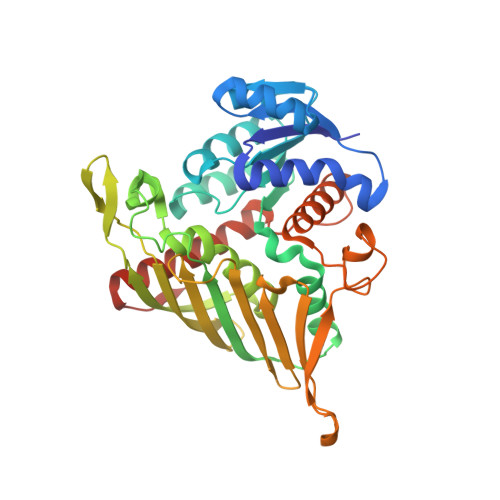Structural basis of L-glucose oxidation by scyllo-inositol dehydrogenase: Implications for a novel enzyme subfamily classification
Fukano, K., Ozawa, K., Kokubu, M., Shimizu, T., Ito, S., Sasaki, Y., Nakamura, A., Yajima, S.(2018) PLoS One 13: e0198010-e0198010
- PubMed: 29799855
- DOI: https://doi.org/10.1371/journal.pone.0198010
- Primary Citation of Related Structures:
5YA8, 5YAB, 5YAP, 5YAQ - PubMed Abstract:
For about 70 years, L-glucose had been considered non-metabolizable by either mammalian or bacterial cells. Recently, however, an L-glucose catabolic pathway has been discovered in Paracoccus laeviglucosivorans, and the genes responsible cloned. Scyllo-inositol dehydrogenase is involved in the first step in the pathway that oxidizes L-glucose to produce L-glucono-1,5-lactone with concomitant reduction of NAD+ dependent manner. Here, we report the crystal structure of the ternary complex of scyllo-inositol dehydrogenase with NAD+ and L-glucono-1,5-lactone at 1.8 Å resolution. The enzyme adopts a homo-tetrameric structure, similar to those of the inositol dehydrogenase family, and the electron densities of the bound sugar was clearly observed, allowing identification of the residues responsible for interaction with the substrate in the catalytic site. In addition to the conserved catalytic residues (Lys106, Asp191, and His195), another residue, His318, located in the loop region of the adjacent subunit, is involved in substrate recognition. Site-directed mutagenesis confirmed the role of these residues in catalytic activity. We also report the complex structures of the enzyme with myo-inositol and scyllo-inosose. The Arg178 residue located in the flexible loop at the entrance of the catalytic site is also involved in substrate recognition, and plays an important role in accepting both L-glucose and inositols as substrates. On the basis of these structural features, which have not been identified in the known inositol dehydrogenases, and a phylogenetic analysis of IDH family enzymes, we suggest a novel subfamily of the GFO/IDH/MocA family. Since many enzymes in this family have not biochemically characterized, our results could promote to find their activities with various substrates.
Organizational Affiliation:
Department of Bioscience, Tokyo University of Agriculture, Setagaya-ku, Tokyo, Japan.
















